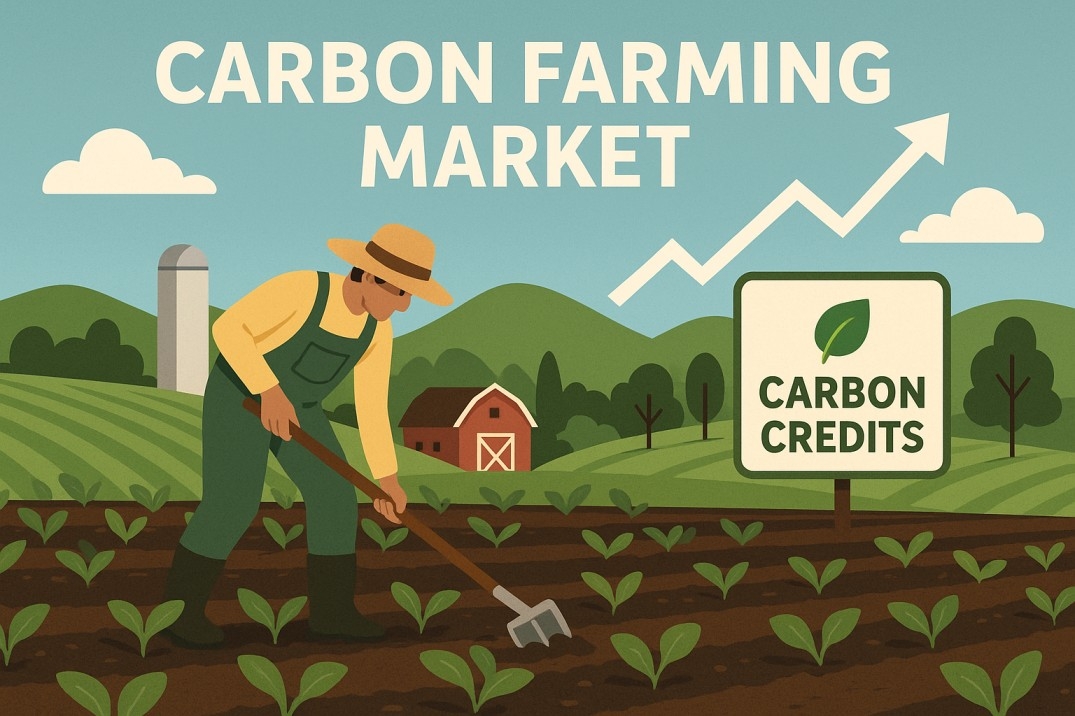Introduction
The global carbon farming market is witnessing remarkable growth as nations and industries push for climate resilience, net-zero targets, and sustainable agriculture. According to BIS Research, the market is expected to grow from $531.8 million in 2024 to $2,341.2 million by 2034, expanding at a CAGR of 15.98% during the forecast period. This press release provides in-depth insights into market drivers, segmentation, challenges, and regional trends shaping the future of carbon farming.
What is Carbon Farming and Why Is It Important?
Carbon farming refers to the use of land management techniques that increase the carbon content of soil and vegetation to help offset greenhouse gas emissions. Practices like cover cropping, no-till farming, crop rotation, agroforestry, and biochar application are helping farmers capture and store carbon, while simultaneously improving soil health, water retention, and crop yield.
With agriculture contributing approximately 11% of global GHG emissions, carbon farming is seen as a dual-purpose solution: addressing climate change while enhancing agricultural productivity.
What Is Driving the Growth of the Carbon Farming Market?
Several key factors are propelling market expansion:
-
Rising Carbon Credit Demand: Industries aiming to meet net-zero goals are increasingly purchasing agricultural carbon offsets, offering farmers a new source of income.
-
Government Incentives: Initiatives like the USDA’s $2.8 billion Climate-Smart Commodities program and the EU’s Carbon Removal Certification Framework (2024) provide robust policy support.
-
Corporate Sustainability Goals: Companies are adopting ESG mandates and integrating carbon farming into their supply chains to improve environmental footprints.
-
Technological Advancements: Tools like satellite monitoring, IoT soil sensors, and AI-driven analytics are making carbon quantification more accurate and scalable.
Request a Sample for Carbon Farming Market Report
How Is the Market Segmented?
By Application:
-
Agriculture (Leading Segment) Agriculture is expected to dominate the market due to its scalability and carbon sequestration potential through no-till, crop rotation, and organic input use. With the support of subsidies and technical assistance, farmers are adopting regenerative practices that reduce emissions and improve yields.
-
Forestry and Land Use Forestry-focused carbon projects, including reforestation and afforestation, are gaining traction, especially in regions with degraded lands.
By Product:
-
Carbon Management Software (Leading Product) These platforms help track, verify, and monetize carbon sequestration data, aligning with regulatory and corporate reporting requirements. Their integration with satellite imagery and precision farming tools enhances decision-making and transparency.
-
Carbon Measurement and Monitoring Tools Devices and platforms that provide real-time insights into soil carbon levels are essential for verification, helping build credibility in carbon markets.
By Region:
-
North America (Leading Region) The U.S. and Canada are leading due to supportive policy frameworks, advanced agri-tech adoption, and mature carbon trading systems. Growing corporate demand for offsets also strengthens regional dominance.
-
Europe Backed by strong regulatory standards such as the EU Carbon Removal Certification, Europe is rapidly scaling up carbon farming.
-
Asia-Pacific Emerging economies are leveraging carbon farming to boost climate resilience and improve smallholder farmer incomes.
Visit Our Agriculture Market Page
What Are the Key Trends in the Market?
-
Regenerative Agriculture Boom: Increasing adoption of techniques that enhance biodiversity, soil structure, and carbon storage.
-
Digitalization of Agriculture: Deployment of AI-based platforms, remote sensing, and precision farming tools for real-time monitoring and ROI tracking.
-
Partnership Models: Collaborations between agribusinesses, startups, environmental NGOs, and governments to co-develop and deploy carbon farming solutions.
What Challenges Could Hinder Growth?
-
Volatile Carbon Credit Pricing: Prices vary across voluntary and compliance markets, making it difficult for farmers to predict ROI.
-
Verification Complexity: Accurately measuring and certifying soil carbon storage is technically demanding and requires standardized protocols.
-
Market Fragmentation: Diverse carbon farming standards, platforms, and incentive structures may cause confusion and reduce scalability.
Addressing these challenges requires the development of clear regulatory frameworks, transparent carbon accounting protocols, and education for farmers on long-term benefits.
What Are Some Recent Developments?
-
Bayer ForwardFarm (India, Sept 2024): Bayer introduced climate-resilient practices like vermicomposting and soil carbon capture tailored for smallholder farms.
-
Soil Capital Series B Funding ($16.2M, Sept 2024): The agritech firm will scale regenerative initiatives in Europe, targeting over 1,600 farmers.
-
GrowUp Farms x Wilder Carbon (May 2023): This partnership supports rewilding projects, contributing to biodiversity and carbon sequestration goals.
What Opportunities Lie Ahead?
The carbon farming ecosystem offers immense growth potential:
-
Research & Innovation: Development of AI tools, biochar technologies, and soil analytics can further improve carbon capture.
-
Market Expansion: Collaborations with international funding agencies and climate financing organizations can help farmers in developing countries participate in global carbon markets.
-
Education and Awareness: Building farmer capacity and increasing awareness of climate-smart agriculture will accelerate adoption rates.
Competitive Landscape
The market is increasingly competitive, with startups, agritech firms, and ESG-focused investors playing pivotal roles. Key players are investing in R&D, software integration, and farmer outreach programs to scale adoption. The market is also witnessing consolidation and cross-sector partnerships aimed at enhancing product offerings and market access.
Conclusion
The carbon farming market represents a high-impact solution for climate change mitigation, sustainable agriculture, and rural economic growth. With regulatory tailwinds, corporate commitments, and technological breakthroughs, the industry is poised for a transformative decade ahead.
About BIS Research
BIS Research is a global market intelligence firm delivering insights on emerging technologies and high-growth industries. We help businesses stay ahead with in-depth reports, custom research, and go-to-market strategies tailored to your goals.
Explore our Custom Research and Go-To-Market Strategy services.
Head of Marketing
Email: media@bisresearch.com
BIS Research Inc.
39111 PASEO PADRE PKWY STE 313,
FREMONT, CA 94538-1686
Media Contact
Company Name: BIS Research
Contact Person: Bhavya Banga
Email: Send Email
Phone: +1-510-404-8135
Address:39111 PASEO PADRE PKWY STE 313, FREMONT CA 94538
Country: United States
Website: https://bisresearch.com/industry-report/carbon-farming-market.html






